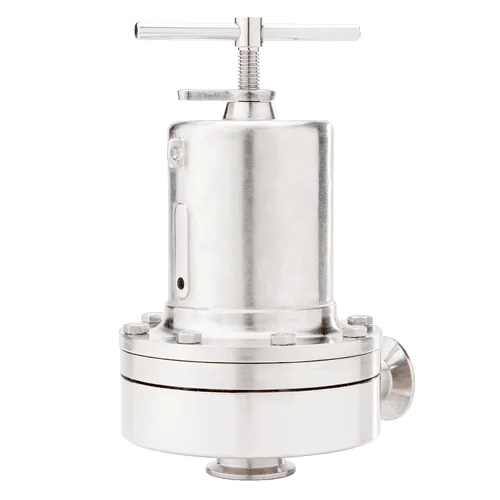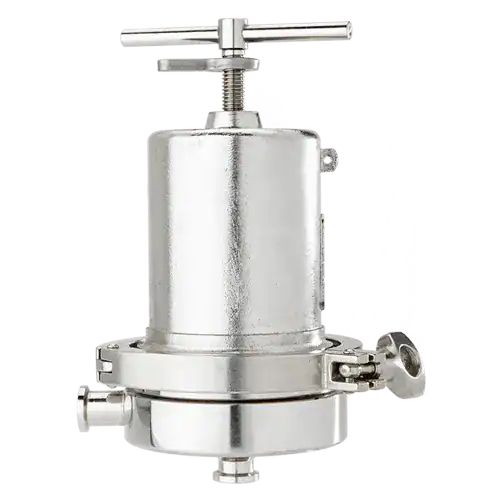Sanitary Pressure Reducing Valves
Steriflow Valve has a large line of sanitary pressure reducing valves and regulators to meet many different specifications and applications, all with a Jorlon™ lifetime diaphragm warranty.
What are sanitary pressure reducing valves?
Sanitary pressure reducing valves are pressure-reducing valves (or regulators) for clean services. These valves rescue the pressure at the valve’s outlet.
Types Of Sanitary Pressure Reducing Valves We Carry
Request a quote from a variety of pharma process and clean utility pressure reducing valves, 1/2" - 3" (DN15 - DN80) with tri-clamp or weld ends, low to high flow, manual or air augmented, all with the Jorlon™ lifetime diaphragm warranty.
Looking for our line of Clean Compressed Air & Gas Pressure Reducing Regulators? Click here
Mark 96 Series ⟶
Manual, Low to High Flow, Sanitary Pressure Regulator
Mark 96C Series ⟶
Manual, Low to High Flow, Jorlon Diapragm
Mark 96A Series ⟶
Hybrid or Automated, Jorlon Diaphragm
Mark 96AA Series ⟶
Hybrid or Automated, Jorlon Diaphragm
Your List
Industrial Products
Email List
Get A Quote
For our sanitary pressure reducing valve and regulator pricing, please contact us or request a quote.
How do sanitary pressure reducing valves work?
Sanitary pressure reducing valves (or regulators) monitor the downstream pressure.
The outlet pressure of a sanitary pressure reducing valve is sensed by the underside of the valve diaphragm which is connected to the stem and plug.
If downstream pressure rises the valve moves toward closed to maintain the desired set pressure by reducing the flow allowed to pass to the downstream side.
Benefits Of Using Steriflow Sanitary Pressure Reducing Valves
Some benefits of using a Steriflow sanitary pressure reducing valve or regulator include:
- There is less offset (i.e. the change in set pressure as flow changes). If flow increases the set pressure tends to fall.
- Steriflow sanitary pressure reducing valve’s set pressure won’t fall as much as the leading competitor’s valve.
- Most reliable product offering with the industry’s only guaranteed (lifetime) warranty on the Jorlon diaphragm.
- Steriflow has the only pressure reducing valve (PRV) that does not guide the inlet waterway. Instead, we guide above the diaphragm completely. If the stem is rubbing in the inlet, then microparticles will occur every time the stem moves to regulate. Will eventually contaminate the process.
- The lowest Cvs (Kvs) in the industry.
- The lowest standard pressure setpoints.
- The broadest range of manual and automated configurations.
- The largest variety of connection sizes and types with fractional line sizes to 3″ in imperial and metric tube size with DIN, ISO and ASME BPE clamp configurations as standard.
For more information or guidance on selecting a sanitary pressure reducing valve, get in touch with our team.
Industry Applications For Sanitary Pressure Reducing Valves
Our sanitary pressure reducing valves and regulators are ideal for the pharmaceutical and biopharmaceutical industries. Some different applications for our pressure reducing valves include, but are not limited to:
- Clean steam pressure reduction for SIP (steam in place)
- Reducing clean utilities and process pressures for buffers and WFI (water for injection)
- Reducing the pressure of gasses (02, clean sterile air, and CO2) that are sparged into bioreactors
Contact us for more information on the different applications of our pressure reducing regulators.
Frequently Asked Questions
1. What is the CIP/SIP compatibility for your sanitary pressure reducing valves (or regulators)?
Our sanitary pressure reducing valves have complete compatibility.
CIP are usually caustic (alkaline), acid, or oxygenating agents. Therefore all our materials are compatible. Since SIP is just clean steam, therefore, no one will have a compatibility issue with SIP.
2. How does someone select the right sanitary pressure reducing valve (or regulator)?
Sizing and selecting a sanitary pressure reducing valve involves 3 key elements:
- P1: Inlet Pressure
- P2: Outlet Pressure/Set Point
- P3: Flow
If you know those three things, we can easily help you size and select the right sanitary pressure reducing valve.






